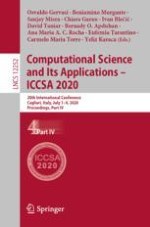2020 | Book
Computational Science and Its Applications – ICCSA 2020
20th International Conference, Cagliari, Italy, July 1–4, 2020, Proceedings, Part IV
Editors: Prof. Dr. Osvaldo Gervasi, Beniamino Murgante, Prof. Sanjay Misra, Dr. Chiara Garau, Ivan Blečić, David Taniar, Dr. Bernady O. Apduhan, Ana Maria A. C. Rocha, Prof. Eufemia Tarantino, Prof. Carmelo Maria Torre, Prof. Yeliz Karaca
Publisher: Springer International Publishing
Book Series : Lecture Notes in Computer Science
